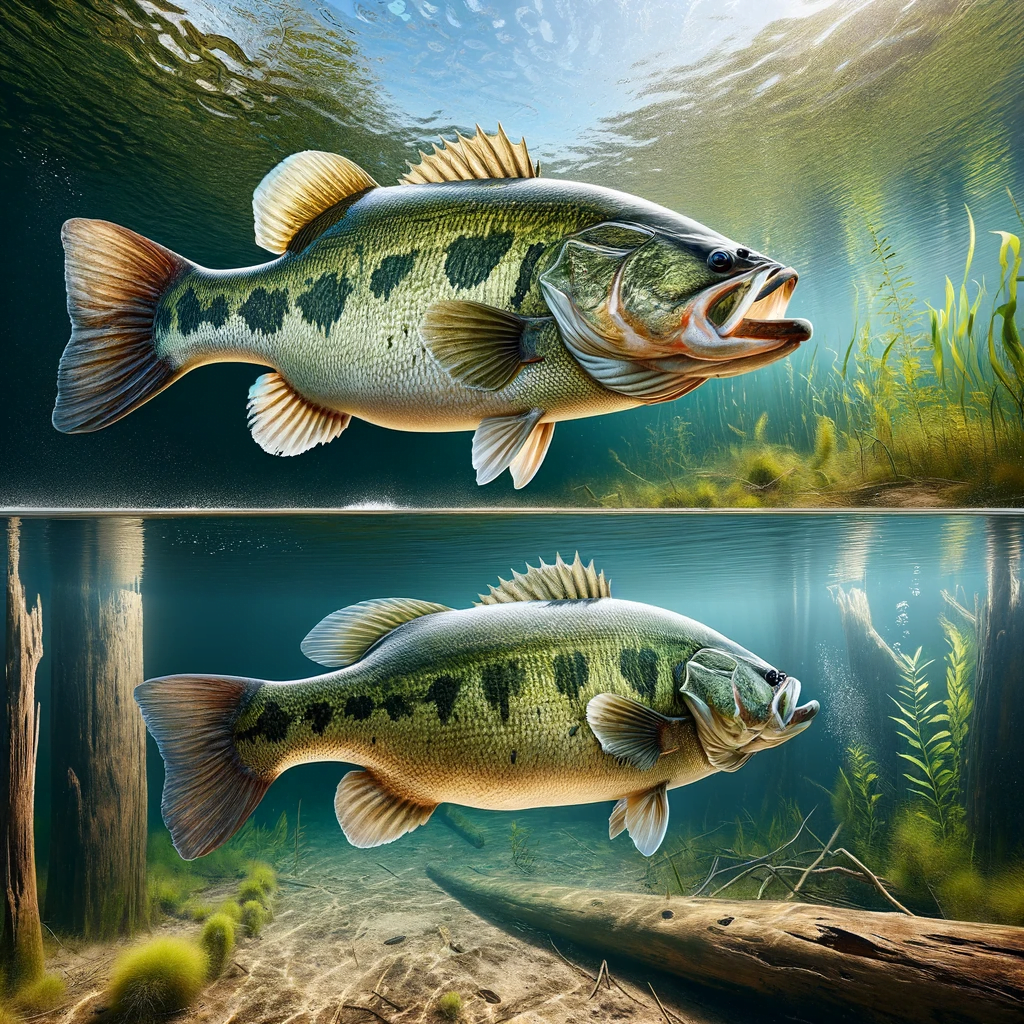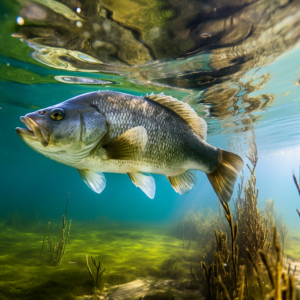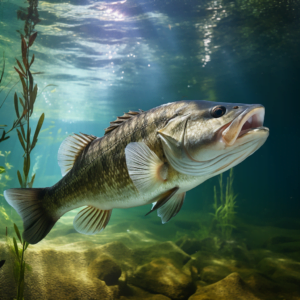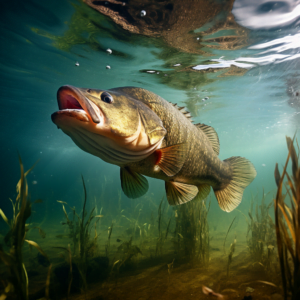Where Are Largemouth Bass Native In North America?
The iconic largemouth bass (Micropterus salmoides) stands as one of the most popular and highly pursued freshwater game fish species across North America today. Anglers eagerly seek out trophy “lunker” bass reaching over 10 pounds in weight to best in friendly tournaments and for bragging rights. However, largemouth bass are actually native to only the central and eastern regions of the United States and Canada, where they naturally evolved and thrived for thousands of years before widespread introductions took place.
Within its ancestral range, the largemouth bass occupies warm, quiet waters across an expansive area stretching from the Mexico border northwards to southern Canada, and from the Rocky Mountains eastward to the Atlantic. The native range extends through the Great Lakes region, Midwest, Mid-Atlantic, and the southeastern U.S., which represents the historic heartland of the species. Here in the Southeast, largemouth bass prospered for eons within shallow weedy lakes, bayous, wetlands and muddy rivers flowing through lowland floodplains. Over time, the largemouth became superbly adapted to its environment as an ambush predator feeding upon small fish, crustaceans and other aquatic prey.

Current native and introduced range of largemouth bass (Micropterus salmoides) – Lacepède, 1802. Native range indicated by dashed line, introduced range indicated by shaded regions. Figure from USGS Nonindigenous Aquatic Species Database.
While humans have widely introduced largemouth bass far beyond their native range for recreational fishing opportunities, understanding the natural origins of largemouth bass provides insight into properly managing and sustaining populations. Within ancestral largemouth waters, fisheries managers can look to naturally occurring habitat features, prey sources, water quality parameters, and reproductive factors that enable resilient, self-sustaining bass populations with minimal intervention.
Today, anglers pursue lunker largemouth bass in places as far flung as South Africa, Japan, Hawaii, Mexico and Cuba. However, the species reached its apex through eons of adaptation in the lakes, bayous and rivers of the eastern United States.
The Natural Habitat of Largemouth Bass
Largemouth bass inhabit a variety of warm freshwater ecosystems across their native range, but generally prefer waters with abundant aquatic vegetation, low water clarity, and structure for nesting and ambushing prey. The largemouth thrives in shallow weedy areas of lakes, oxbow lakes, ponds, wetlands, impoundments and sluggish streams across the southern and central U.S.
Prime largemouth habitat contains plant-choked shallows reaching 3 to 6 feet deep with submerged wood cover such as stumps, logs and overhanging trees. Largemouth lurk in these places to ambush schools of baitfish as well as larger prey like shad, bluegill, crawfish and frogs. A mix of open water and thick mats of pondweed, milfoil, hydrilla and other aquatic vegetation provide both forage habitat and ambush sites. Low-light conditions offered by tea-stained waters or canopy cover help bass remain concealed.
In riverine environments, largemouth gravitate towards backwaters, sloughs, oxbow lakes and bayous surrounded by flooded timber. Slow currents allow aquatic plants like coontail, water willow and lotus to flourish in the soft, silty bottom. Marshes, cypress swamps and weedy shallow impoundments also make excellent largemouth habitat across the South.
While generally dwelling in depths of 10 feet or less, largemouth will retreat to holes of 15 to 30 feet during period of extreme summer heat or winter cold. Submerged humps, ledges, ditches and creek channels that connect shallows to deeper basins provide necessary refuge. Rocks, stumps, docks and other cover in deeper areas give largemouth ambush points to intercept suspended baitfish.
Largemouth build spawning nests in very shallow water from 1 to 3 feet deep. They prefer sandy, silty or mud flats protected by emergent vegetation such as cattails, bulrushes or shrubs. In lakes, the upper reaches of feeder creek arms are prime spawning territory. High, stable water levels are crucial during the spawn, which commences once temperatures reach 60-65°F, typically in late spring. Males fan out saucer-shaped redds and guard the fertilized eggs and fry. Newly hatched bass stay shallow and feed on plankton and insects. Vegetated shallows shelter the vulnerable fingerlings from predators.
Ideal largemouth habitat contains both shallow, complex weed beds and slightly deeper sections of open water. This mix enables growth of abundant prey fish populations and ambush opportunities for trophy bass.
States Where Largemouth Bass Originated
Though found across much of the eastern third of North America today, largemouth bass originally evolved within certain regions and watersheds after the last Ice Age. Native largemouth populations still thrive in these original homelands:
- Southeastern States – The warm, shallow lakes and weedy backwaters from Florida up through Georgia, Alabama, Mississippi and Louisiana comprise the historic heartland of largemouth bass. The Suwannee River, Lake Okeechobee, Lake Seminole, Santee Cooper lakes and lower Mississippi River backwaters are bass strongholds. Many world record lunkers up to 17 pounds have come from Florida waters.
- Central Plains/Ozarks – The bass-rich rivers and man-made reservoirs of southern Missouri, eastern Oklahoma, Arkansas and eastern Texas mimic the sluggish pools and oxbows preferred by largemouth. Toledo Bend Reservoir along the Texas/Louisiana border covers 185,000 acres and produces giant bass exceeding 15 pounds.
- Mid-Atlantic Region – Largemouth bass thrive in rivers and impoundments across the Carolinas, Virginia, Maryland, Delaware and New Jersey. The weedy tidal waters in the Chesapeake Bay region and coastal areas like the Dismal Swamp Canal are especially productive. Lake Wylie on the Catawba River claimed the former world record bass of over 22 pounds.
- Northeast – Along the Atlantic seaboard, native largemouth range as far north as interior Maine and southern Quebec and the St. Lawrence River valley. While not as abundant or large as smallmouth bass in clear northern lakes, big largemouth haunt weedy places like Lake Champlain.
- Upper Midwest – From the eastern Dakotas through Minnesota, Wisconsin and the western Great Lakes states, largemouth bass evolved within glacial lakes, marshes and sluggish rivers. Top fisheries include Lake Minnetonka, Lake Mille Lacs and Pool 8 of the Mississippi River along Minnesota’s border with Wisconsin.
Here are some top trophy largemouth bass fisheries within the native range:
- Santee Cooper Lakes (South Carolina)
- Lake Seminole (Georgia/Florida)
- Sam Rayburn Reservoir (Texas)
- Toledo Bend Reservoir (Texas/Louisiana)
- Lake of the Ozarks (Missouri)
- Lake Anna (Virginia)
- Lake Champlain (New York/Vermont)
- St. Lawrence River (New York)
- Lake Guntersville (Alabama)
- Lake Minnetonka (Minnesota)
- Lake Kissimmee (Florida)
Why Largemouth Bass Thrive in the Southeastern U.S.
The Southeastern states represent the historic heartland and stronghold for largemouth bass, where habitat conditions enable the species to prosper and grow to trophy proportions. Several key factors make this region so productive for largemouth bass:
- Warm climate year-round enables fast metabolism and growth rates. Winters are mild enough for bass to feed and gain weight most of the year.
- Numerous shallow, weedy lakes and wetlands provide perfect ambush habitat. Aquatic plants like hydrilla and milfoil support plentiful prey.
- Long growing season allows baitfish populations like shad, bream and shiners to boom and provide forage.
- Spawning temperatures in the 60s can be reached early in spring and extend into summer, allowing multiple spawns.
- Fertile floodplains and ample rain expand bass habitat and improve spawning success during high water.
- Low elevation and lack of coldwater inputs prevent winterkill during harsh weather.
These favorable conditions allow largemouth bass to grow fast, live long and reach lunker proportions. While 8-10 pounders are trophies, it’s not uncommon for bass over 15 pounds to be caught in Florida waters. The former world record of 22 pounds, 4 ounces came from Montgomery Lake in Georgia in 1932.
The Introduction of Largemouth Bass Outside Their Native Range
While largemouth bass evolved within central Eastern North America, humans have intentionally introduced them far beyond their native range over the past 150 years. Starting in the late 1800s, bass were stocked outside their home waters by private groups and state agencies hoping to establish new fisheries. These authorized introductions accelerated after the turn of the century.
Initially, largemouth bass were transplanted from their native Southeastern waters into reservoirs and lakes out West to provide exciting freshwater angling opportunities where native fish fauna was lacking. Stockings into California, Arizona and other Western states took place around the early 1900s. Later, Texas lakes and Hawaiian waters received bass, followed by countries around the world.
Now firmly established on every continent except Antarctica, Florida-strain largemouth bass have been introduced to at least 45 U.S. states and over 60 countries worldwide for recreational fishing. Thanks to their hardiness, rapid growth and great fighting spirit, introduced largemouth bass often quickly multiply and thrive in reservoirs, lakes and ponds spanning diverse landscapes and latitudes.
Notable Areas Stocked Outside Native Range:
- Western U.S. – California, Arizona, Nevada, Utah, Colorado, New Mexico lakes and reservoirs. Mexico.
- Great Plains – Nebraska, the Dakotas. Texas stocked many reservoirs.
- Mid-Atlantic – DelMarVa Peninsula.
- Northeast – Bass introduced to Adirondack lakes, New Hampshire.
- Hawaii, Japan, Philippines and Pacific islands. Bass brought to many tropical nations.
- Europe – Spain, France, Italy, UK,Netherlands and Eastern Europe.
- Africa – South Africa, Kenya, Zimbabwe, Egypt. Bass introduced to many African lakes and rivers.
- South America – Widely spread across Venezuela, Brazil, Peru, Argentina.
- Australia. Introduced in the 1960s and spread quickly.
However, the human practice of transplanting largemouth bass for sport fishing has not been without ecological consequences. Introducing apex predators like largemouth bass into areas outside their native range can significantly impact native fish communities and food webs. As opportunistic generalist feeders, largemouth prey heavily upon smaller fish species, reducing their numbers. Competition with native game fish like trout or sunfish can also occur. Other ecosystem effects from non-native bass range from declines of rare amphibians to influencing waterfowl nesting.
These types of impacts have spurred criticism of introducing bass and led to more careful evaluation before additional stockings take place. However, largemouth bass are firmly entrenched across North America and in most countries where introduced. Ongoing research examines management strategies to balance bass fisheries with conserving native biodiversity.
Fishing for Largemouth Bass Across North America
Thanks to extensive introductions beyond their home waters, largemouth bass now thrive in lakes and rivers across North America. From Florida to California and beyond, bass fishing has exploded in popularity with millions of anglers eagerly pursuing bucketmouths. Largemouth are highly prized for their fighting spirit in battling anglers, hard strikes on lures, and culinary quality.
Legendary Trophy Bass Fisheries
Some of the continent’s top destinations for catching lunker largemouth bass outside their native range include:
- California – Clear Lake, Lake Cachuma, Diamond Valley Lake, Casitas Lake. The state record is a mammoth 21.7 pounder from Lake Miramar.
- Texas – Sam Rayburn Reservoir, Toledo Bend Reservoir, Lake Fork. Numerous double-digit bass.
- Mexico – Lake Baccarac in northern Mexico is a bass paradise, producing the world record of 22.5 pounds. Other lakes like El Salto, Guerrero also have big bass.
- Hawaii – Lake Wilson on Oahu gives up bass over 15 pounds. Other islands also have excellent bass fishing.
- South Africa – Lake Jozini is a top destination for huge bass, including a 19 pounder.
- Japan – Man-made reservoirs across Japan harbor giant bass, especially Lake Ikehara.
- Australia – Bass introduced Down Under in the 1960s quickly multiplied in the Murray River and spread. Many 6-10 pound fish caught.
Techniques for Catching Lunker Bass
Largemouth bass aggressively strike a wide range of artificial lures, making them a thrilling game fish to catch. Top lure types and rigs for fooling trophy bass include:
- Hard baits – Crankbaits, jerkbaits, lipless rattling baits like swimbaits are great for covering water and triggering reaction bites.
- Topwaters – Buzzbaits, poppers, stickbaits provoke exciting surface strikes during low light periods or around vegetation.
- Jigs – Bass jigs tipped with soft plastic trailers are ideal for flipping/pitching around heavy cover and structure.
- Soft plastics – Worms, craws, grubs excel for finesse tactics with light jigheads or Texas rigs.
- Spinnerbaits and spinners – Great for covering shallow zones and triggering reaction bites with flash and vibration.
- Umbrella rigs – Multiple lure setups can mimic baitfish schools and draw big bass.
- Swimbaits – Big paddle tail and boot tail swimbaits realistically imitate wounded baitfish.
- Live bait – Where permitted, using shiners, bluegill, crawfish produces trophy bass.
Added to their eager biting habits, largemouth bass are aggressive fighters that make screaming runs, surface jumps and dives when hooked. Anglers must use stout bass rods, reels and line to land hogs over 10 pounds.
Catch-and-release is critical for preserving trophy bass fisheries. Proper handling and prompt live release allows big breeder fish to return and spawn.
Conclusion: The Native Origins and Expanded Range of Largemouth Bass
In summary, the iconic largemouth bass is native to the central and eastern regions of the United States and Canada. The historic heartland of largemouth bass centers on the warm, weedy waters of the Southeastern states. Here in fertile lakes and rivers of the South, largemouth bass evolved and thrived for millennia as ambush predators perfectly adapted to their habitat.
While confined to central Eastern North America historically, intentional introductions have spread largemouth bass far beyond their native range over the past century. Transplants across the continental U.S., Hawaii, Japan, Mexico, South Africa and other global destinations have created popular largemouth fisheries. However, impacts on native species have resulted in more careful evaluation of introducing non-native fishes.
Thanks to this vast expanded range, largemouth bass now provide extremely popular sport fisheries across North America and internationally. Their aggressive fighting spirit when hooked, eagerness to strike artificial lures, and great table quality have made them a premier freshwater game fish pursued by millions. Proper management and responsible catch-and-release practices help maintain trophy bass fisheries.
Understanding the origins, habitat requirements, and introduction history of largemouth bass provides crucial insight for fisheries managers working to conserve these iconic fish. Within their ancestral home waters in the South, bass have shown the ability to thrive and grow to lunker proportions for ages. Careful study of native bass lakes and reservoirs reveals the natural conditions and ecological factors that allow bass populations to flourish across generations.
Where largemouth roam beyond their original range, managers must work to foster sustainable fisheries while minimizing impacts upon native species. Ongoing research continues to reveal new tactics for balancing bass fishing opportunities with conservation of diverse aquatic ecosystems. Thanks to dedicated management and stewardship from anglers, future generations can continue experiencing the excitement of hooking into a hard-fighting bucketmouth – across the U.S. and beyond.




